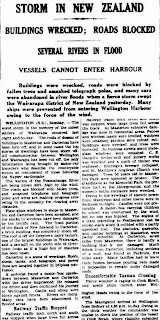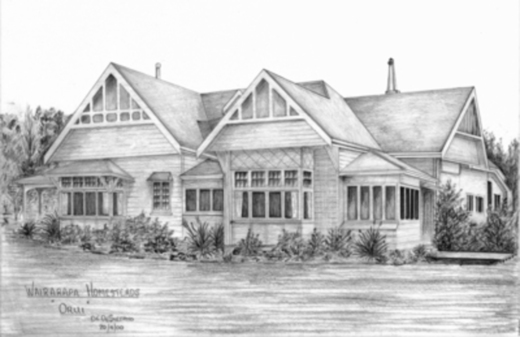The Great Storm: October 1, 1934
 |
| STORM IN NEW ZEALAND. (1934, October 2). The Argus(Melbourne, Vic. : 1848 - 1956), p. 9 |
STORM IN NEW ZEALAND
BUILDINGS WRECKED; ROADS BLOCKED
SEVERAL RIVERS IN FLOOD
VESSELS CANNOT ENTER HARBOUR
Buildings were wrecked, roads were blocked by fallen trees and smashed telegraph poles, and many cars were abandoned in river floods when a fierce storm swept the Wairarapa district of New Zealand yesterday. Many ships were prevented from entering Wellington Harbour owing to the force of the wind.
WELLINGTON (N.Z.), Monday. The worst storm in the memory of the oldest settlers of Wairarapa occurred last night and to-day. The roofs of dozens of buildings in Masterton and Carterton have been torn off, and in some cases the top stories of dwellings have been shorn off. All communication between Wellington and Wairarapa has been cut off, the only information being brought by motor-car travellers who describe the countryside scenes as reminiscent of those following the Napier earthquake.
The waters of the Ruamahanga River are being blown 50ft. high by the wind. The roads are blocked with fallen trees, and smashed telephone and telegraph poles and wires are making progress slow owing to the necessity for clearing away obstacles.
Plate-glass windows in shops in Masterton and Carterton have been smashed, and the stocks in windows have been damaged by the terrific rain. The front portion of the Bank of New Zealand in Carterton, a brick building, was completely shorn off. The roof is off the Greytown dairy factory, one of the largest buildings in Wairarapa, and a sawmill on the south side of Grey town looks as if a huge box of matches has been upset.
Carterton is a scene of wreckage. Roofs, sheds, tanks, and telegraph and power lines are tangled together in helpless confusion.
 |
| Bus blown over 01-219/5.digital |
A motorist found a motor-bus upside down between Masterton and Carterton with the driver imprisoned. He released the driver and then continued his journey to Wellington. Cattle and sheep were blown against fences. Rivers are rising. Many cars have been abandoned in flooded areas.
Railway Traffic Stopped
Railway traffic both north and south was stopped when large trees fell across the track. At Masterton extensive damage was done in residential areas. Fences and wireless masts were levelled, windows were smashed, gardens were ruined, out-buildings were wrecked, and trees were uprooted. In business streets many plate glass windows were smashed. C. E. Daniell's timber-mill and joinery works was wrecked mid a stack of timber was scattered. Burridge's brewery collapsed, and St. Matthew's Anglican Church was damaged. Trees 50 years old in Masterton Park were uprooted or broken. |
| Grandstand at the Cameron and Soldiers Memorial Park- 02-94/1.digital |
The grandstand at the Memorial Park, the produce hall at the showgrounds, and the women's baths enclosure were wrecked.
Owing to the wreckage of electric power lines, Masterton and other towns were in darkness to-night. Candles were not procurable. A motor-bus carrying children to school was overturned by the wind, but no one was injured. The engine of a train travelling to Featherston lost its smoke-stack when it collided with a partly uprooted tree. The abattoirs, gasworks, and similar buildings at Masterton were partly unroofed.
Owing to the wreckage of electric power lines, Masterton and other towns were in darkness to-night. Candles were not procurable. A motor-bus carrying children to school was overturned by the wind, but no one was injured. The engine of a train travelling to Featherston lost its smoke-stack when it collided with a partly uprooted tree. The abattoirs, gasworks, and similar buildings at Masterton were partly unroofed.
 |
| Knutson and Jamieson (builders) factory in Broadway, Carterton, after storm - - 08-60/197.digital |
At Carterton, seven miles from Masterton, there is hardly a building that is not damaged. Much debris from Carterton, including sections of a roof, was found at Parkvale, five miles away. Many families had to leave their homes because pouring rain made it impossible to remain under damaged roofs.
The Maunganui arrived at Wellington from Sydney at 4.30 p.m. to-day. Owing to the thick weather the commander was unable to check the position of the vessel in Cook Strait, where visibility extended for only half a mile. The liner had to "feel" its way toward port, travelling at slow speed.
The voyage across the Tasman was uncomfortable for the passengers owing to a heavy swell. On Saturday Mrs. J. Verngreen was thrown against a hatch as the vessel rolled, cutting her forehead, face, and knee. She had recovered sufficiently to walk down the gangway to-day unaided.
"STORM IN NEW ZEALAND." The Argus (Melbourne, Vic. : 1848 - 1956) 2 Oct 1934: 9. Web. 15 Jan 2013 <http://nla.gov.au/nla.news-article10961000>.
Uncomfortable Tasman Crossing
Fierce weather is raging in Cook Strait, and many ships cannot enter Wellington Heads owing to the force of the wind.The Maunganui arrived at Wellington from Sydney at 4.30 p.m. to-day. Owing to the thick weather the commander was unable to check the position of the vessel in Cook Strait, where visibility extended for only half a mile. The liner had to "feel" its way toward port, travelling at slow speed.
The voyage across the Tasman was uncomfortable for the passengers owing to a heavy swell. On Saturday Mrs. J. Verngreen was thrown against a hatch as the vessel rolled, cutting her forehead, face, and knee. She had recovered sufficiently to walk down the gangway to-day unaided.

Comments
Post a Comment